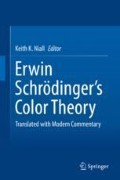Abstract
There are familiar relations among colors which remain unrepresented in the affine geometry of basic colorimetry. An advanced colorimetry will incorporate maximum color similarity. Advanced colorimetry applies Riemannian geometry, not Euclidean geometry. A line element is proposed for color space; it preserves additivity of brightness. The line element bridges heterochromatic differences and just-noticeable differences in color. One problem is that the Bezold-Brücke phenomenon pervades this range of conditions; a correction factor must then be applied to the line element. Then two constraints conflict: the constraint that both large and small differences are accounted for, and the constraint that Fechner’s law holds uniformly across color space. This tension changes the theory of advanced colorimetry to a transitional theory or heuristic account.
Schrödinger, E. (1920c). Grundlinien einer Theorie der Farbenmetrik im Tagessehen. III. Mitteilung. Annalen der Physik, vierte Folge, 63(22), 481–520. Copyright © 2006, as renewed. Translated with permission from Wiley-VCH Verlag GmbH & Co. KGaA.
Author information
Authors and Affiliations
Editor information
Editors and Affiliations
Rights and permissions
Copyright information
© 2017 Springer International Publishing AG
About this chapter
Cite this chapter
Niall, K.K. (2017). Outlines of a Theory of Photopic Colorimetry (Part III): Advanced Colorimetry, or Full-Blooded Colorimetry (Second Article). In: Niall, K. (eds) Erwin Schrödinger's Color Theory. Springer, Cham. https://doi.org/10.1007/978-3-319-64621-3_4
Download citation
DOI: https://doi.org/10.1007/978-3-319-64621-3_4
Published:
Publisher Name: Springer, Cham
Print ISBN: 978-3-319-64619-0
Online ISBN: 978-3-319-64621-3
eBook Packages: Physics and AstronomyPhysics and Astronomy (R0)

